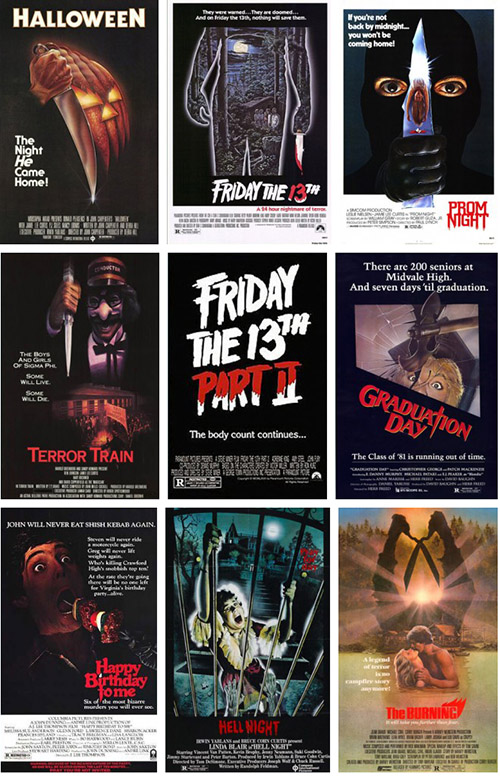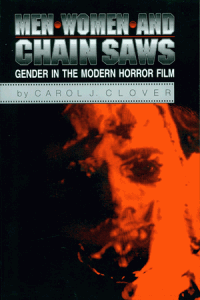Slashademics
Tell most people you’re “into” slasher movies and they’ll give you this strange sideways look, like they’re doubting the authenticity of the complexities going on inside your cranium.
Pick up any academic film book and you’ll likely only find half a paragraph about slasher movies, writing them off as something like ‘hate-women films’ or the like.
Nevertheless, beyond the Teenage Wasteland’s, Legacy of Blood’s, and Going to Pieces’s’s’s, there has been a fair bit of scholarly study done over the years, much of it in research papers, but also a few books.
Therefore, if you’re looking to broaden your appreciation of the subtextual elements of the teenie-kill pics you so enjoy, maybe give any of these a go…
 GAMES OF TERROR: HALLOWEEN, FRIDAY THE 13TH AND THE FILMS OF THE STALKER CYCLE
GAMES OF TERROR: HALLOWEEN, FRIDAY THE 13TH AND THE FILMS OF THE STALKER CYCLE
By Vera Dika (1990)
Way back in the mid-90s before DVD and before my parents stopped thinking the internet was evil sent by Satan, the only existing book about exclusively about slasher films was this.
After I’d devoured as much Friday the 13th and Halloween I could and still found myself hungry, Games of Terror introduced to be to six other early stalker films (as she calls them), which took a good six months for me to track down. This being a good decade before everything was reissued on DVD – only a few of these films were readily available on video cassette.
Rather than analyse psychological elements of the films themselves (see Clover, below, for that), Dika pivots her tome on the structural nature of the sub-genre; the ‘games of terror’ refers to how these films work on an interactive level, breaking down the common plot arc (from the event that prompts the killer X-years earlier to the heroine fighting and surviving), and posing the audience questions: Where is the killer? When will they strike? Who is the killer? etc.

The holy clutch of ‘stalker films’
Of the three books, Games of Terror is the easiest to get on with. It’s not overly verbose and doesn’t preach an opinion (again, see Clover for that!) and it enabled me entrance on to my Film Theory degree, which of course, I capped off with a research paper on 90s slasher movies, called Scream Queens and Screaming Queens.
The downside of the tale is that Games of Terror is fucking hard to get hold of. Look on Amazon and gasp at the three-figure prices for which it’s being touted! I took it out from the library about five times.
Aww, libraries… like phoning around old video stores, scouring the Free-Ads and taking the bus for an hour to go and get my copy of Happy Birthday to Me for £7 from a run-down old rental store, it all takes me back!
 MEN, WOMEN, AND CHAIN SAWS: GENDER IN THE MODERN HORROR FILM
MEN, WOMEN, AND CHAIN SAWS: GENDER IN THE MODERN HORROR FILM
By Carol J. Clover (1990)
Now this is a different kettle o’ fish altogether. Less an entire book, more a collection of essays bound together. The chapter Her Body, Himself is devoted exclusively to slasher films, which Clover begins with by stating that the killers murder a string of “mostly female victims,” and then goes on to namecheck a load of films where male victims outnumbered their gal-pals by significant margins.
Lack of objectivity aside, this is a great chapter for psycho-analysis of some of the grittier issues you sometimes find going on under the surface. Clover centres much of her research around The Texas Chain Saw Massacre (which, ironically, the next book all but excludes from being a slasher movie at all!) and posits that all killers are psychosexually motivated to stab pretty young girls over and over in a grim tableau of the regular intercourse they’re incapable of having.
It makes sense, but her research lets her down. Some facts are plain wrong, while others require a lot of convincing. Still, the parts around audience identification with the killer shifting to the allegiance of the final girl are interesting and mostly valid, but read into sometimes in too much detail, especially when it’s widely considered that the core audience for these movies is frankly too dumb to tell the difference.
The rest of the book covers various other genres of horror and cries misogyny a little too easily at some points. Yes, it’s an issue and yes, some slasher movies revel in it, but Hell Night, for example (a film she discusses), certainly isn’t one of them.
 BLOOD MONEY: A HISTORY OF THE FIRST TEEN SLASHER FILM CYCLE
BLOOD MONEY: A HISTORY OF THE FIRST TEEN SLASHER FILM CYCLE
By Richard Nowell (2010)
I only finished reading this book last week. There’s more in common with Dika than Clover, as Nowell charts the business end of the 1978-81 mini-boom of teen slasher films (thereby excluding films that aren’t necessarily tailored for teens, i.e. He Knows You’re Alone).
Nowell’s research levels go far beyond the previous books, though that’s likely because a lot more has been written on the genre in the intervening years. Still, he doesn’t miss a trick, finally pointing out that Clover’s effort has been the only oft-quoted work on the genre, and thus many people have taken her word for gospel thereafter.
Blood Money goes to great lengths to show how the often tiny production companies tailored their films to male AND female audiences, the way trailers were cut to show female bonding and girl-enticing elements of the films (Prom Night being the best example) and, surprisingly, goes to town on pointing out that Halloween was NOT the bootleg blockbuster it’s often painted to be, that it took a long, long time to make its money (much of which came from re-releases well into the 80s) and really showing how a trend starts, peaks, and fades away when it comes to the saturation point in 1981.
The disappointing aspect of this book is that most of the films he charts (those pictured above plus Black Christmas, Silent Scream, My Bloody Valentine, Terror Train, Final Exam, The Prowler, Just Before Dawn, Madman, and The Dorm That Dripped Blood) made much less money than we’re sometimes led to believe. Yeah, they all turned a profit, but some of the amounts were a lot less impressive than their reputations would have you believe, especially in terms of modern money.
* * *
In conclusion – read these! At least some of them. Despite my bitching about it, Carol Clover’s book is quite relevant, just a tad misinformed in place. And if you ever get in an argument with Roger Ebert, Leonard Maltin, or the ghost of Gene Siskel, it’d be handy to be able to quote some of this stuff back!

I really should pick some of these (the good sounding ones) up… too bad the local bookstores all closed. Stupid dying small town.
Also interesting are the few completely original “slasher novels” out there, like Slay Bells, Joy Ride, and Apeshit.
I’ve NEVER seen one in a bookstore!